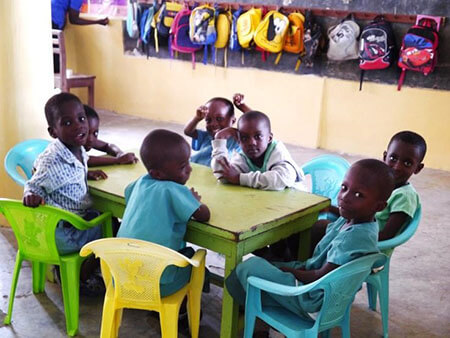7 Years of Loans and 7 Times the Growth: Ahobrase Academy in Ghana
On the seventh day of Christmas, my true love gave to me seven swans-a-swimming...

While reflecting on the seventh day of Christmas, I ran across this photo of seven little sweethearts, (on this seventh day of Christmas we will call them dear little swans) and it got me thinking about the impact of Opportunity International School Improvement loans. Children, just like our seven little swans pictured, are now swimming in opportunities to ensure they build amazing futures and break the cycle of generational poverty – for good.
To take it one step further, Opportunity School Improvement loans are filling new classroom seats and improving the community. Our research shows how massive job creation is one of several amazing outcomes of this growing, high-impact financial product.
Case Study: Ahobrase Academy in Accra, Ghana: As the school goes, so goes the community.
Impact on schools: Ahobrase Academy has been investing Opportunity loans for over seven years, growing from 3 pupils on the family’s front porch to a bustling school of 600 students. Ahobrase has achieved more than 7X growth by leveraging loans to add a two-story classroom block, computer lab, gender separated bathrooms and a cafeteria. The school is creating jobs and using superior curriculum.
Surrounding businesses and community: 24 local business owners including book publishers, seamstresses and tailors cited the school’s growth as being directly responsible for increased income, jobs created and development of youth apprenticeships. A supply shop owner and a baker both said they opened as a direct result of Ahobrase. Local street vendors reported that students, teachers and parents are their primary source of income. The school funded proper drainage in the community and is now collaborating with local officials to pave surrounding roadways.
Teachers: The Academy has created jobs for 28 teachers who say that being paid well and on-time has led to a sense of purpose and stability. Many have funded family members to start their own businesses. We heard over and over that they stay on longer, feel good about developing their skills and even return to school to attain additional credentials.
Students and families: Before Ahobrase, most parents did not send their children to school while a handful walked a great distance. According to the study, there has been a drop in teen pregnancies, attributing the change to the school’s advocacy, and reduction in child abuse in their neighborhoods. Parents were more hopeful for their children’s future.
Conclusion: The impact shown through this brief study is clear and intuitive. Sustainable community-based schools result in job creation, social improvement, deeper and more long-term investment in educational quality, and more educated populations – a recipe for holistic community economic development that begins with the support of a single, socially-focused school proprietor.